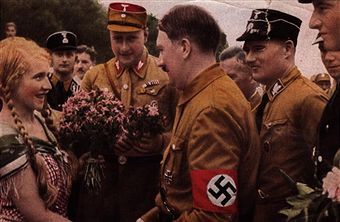
When I worked in Berlin in 1998 the trendy record store in the city’s gay-friendly Schöneberg district had a category called “schwarz” music. It took up a lot of the shop and seemed a bizarrely useless generalisation, given the huge popularity of both imported and home-made Rap music. There was even a whole cluster of GI rap stars – African American soldiers who stayed on after their tour of duty because of the huge German market.
But the record shop captured something of the unsettling oddness that persists in modern multi racial Germany’s mono-racial insistence on labeling and categorisation. Nowhere in Britain could you advertise a “washes whiter” detergent with a very dark skinned African born TV star as you could in Germany in the ‘90s.
Yet the German authorities are passionate about trying to internationalise their arts scene. In Berlin in particular, writers and artists from all over the world are encouraged, often with grants and programmes to come and work there. Ghanian-Canadian Esi Edugyan’s second novel, the Booker shortlisted, Half Blood Blues, is a product of an extended stay in Europe, and combines her love of jazz with a less well known aspect of Nazi persecution.
It started out as a factual book about the Rhineland “bastards” – mixed race Germans born of relationships between German women and French African soldiers after the First World War, “I was living in Europe at the time,” she says, “and being a black woman, feeling very visibly different…My thoughts turned naturally to wondering what became of those children during the fascist years.” She says while it wasn’t easy finding interviewees, she did correspond with an octogenarian who, as a child, had got through the Third Reich years by acting in Nazi propaganda films.
The novel tells the story of a Berlin based jazz band – non-Jewish, Jewish and black. Two are African American and one – Hiero Falk – is a mixed race German, who is the most in danger as they flee Berlin for Paris. When the “Boots” march into the City of Light, Falk is arrested and disappears; his fate, for most of the novel, is unknown.
Edugyan in the end chose to write a book about musical passion, not the history of black Germans. Louis Armstrong appears in the novel, and the intense prose is an impressive attempt to evoke the
power of playing jazz:
“And then, real late, Armstrong come in. I was shocked. Ain’t no bold brass at all. He just trilled in a breezy, casual way, like he giving some dame a second glance in the street
without breaking stride.”
The idea is a great one. Mainstream films have created fiction about how the Nazis treated what they regarded as “degenerate” music and musicians; notably Swing Kids (1993) and the German feature The Comedian Harmonists (1998).
So sold on its setting and its jazz theme, it is a shame that Half Blood Blues is not more ambitious. While the players symbolically attempt a jazz version of the notorious Nazi anthem, the Horst Wessel, the novel settles for an unsatisfying mystery, glibly resolved after German Unification. Its narrator, Sid, is essentially Salieri to Hiero’s Amadeus in a retread of the Peter Schaffer play.
The most compelling aspect of the characterisation, though is the African American Sid’s awareness that he would rather stay in Europe, like Louis Armstrong and Josephine Baker, than return to the segregated hatred of the Land of the Free.
The reader is left wishing for a novel with the meticulous research and emotion of Andrea Levy’s outstanding Small Island. Levy powerfully evoked the clash of cultures in the treatment of black GIs stationed in Britain.
There is in all of us, a part that wonders how would I – my ethnic group – have been treated by the Nazis? And equally importantly, how would my neighbours have treated me in those extraordinary times?
At a mansion in Wannsee, on the rural outskirts of Berlin, you can see the conference table where the Nazis planned and launched their Final Solution like corporate executives at a luxury retreat. Individual pages of statistics are placed at each empty place. Most chilling to British visitors is the typed sheet which lists the estimated number of Jews in Britain in thousands; broken down by region into England, Scotland, Wales.
There were few black Germans of the interwar years in the first place, and so few survive, that their true story is harder to tell though Eduygan’s bibliography names 2 factual books on the subject. The novel only really comes alive in the final third, with its evocation of the panic that engulfs Paris as it falls to the Wehrmacht. We’ve probably seen it in a film or a book before but, as in Spielberg’s version of JG Ballard’s, Empire of the Sun – it is the facts of the fall of Paris or Shanghai that are the most compelling.
Vikram Seth’s Two Lives is a deeply moving biography of his Indian uncle and German Jewish wife who met in 30s Berlin. She made it to London, but her family was murdered in concentration camps. Its power is in what the years of mundane research and interviews uncover. Half Blood Blues suffers by using the Third Reich, ultimately, only as a backdrop. When it comes to the Nazis, the truth is always more powerful than fiction.





Comments